
The Project Gutenberg EBook of Breeding minks in Louisiana for their fur, by William Andre Elfer This eBook is for the use of anyone anywhere at no cost and with almost no restrictions whatsoever. You may copy it, give it away or re-use it under the terms of the Project Gutenberg License included with this eBook or online at www.gutenberg.org/license Title: Breeding minks in Louisiana for their fur Author: William Andre Elfer Release Date: July 7, 2012 [EBook #40157] Language: English Character set encoding: ISO-8859-1 *** START OF THIS PROJECT GUTENBERG EBOOK BREEDING MINKS IN LOUISIANA *** Produced by Tom Cosmas and the Online Distributed Proofreading Team at http://www.pgdp.net (This file was produced from images generously made available by The Internet Archive)

FOR THEIR FUR

BY
William André Elfer
FOR SALE BY THE
GESSNER CO.,
611 CANAL ST., NEW ORLEANS, LA.
COPYRIGHTED
BY
W. A. ELFER
1909
Press of J. G. Hauser
"The Legal Printer"
620-622 Poydras St.
New Orleans
PREFACE
his little volume is issued in illustration of the feasibility of breeding minks in Louisiana for their fur. It is the result of experiments conducted by the author himself, and he feels that it should be of interest to many and of value to the few who are looking for fields for profitable investment. It is the author's aim to issue a more elaborate work on the same subject sometime during the early part of next year.
W. A. E.
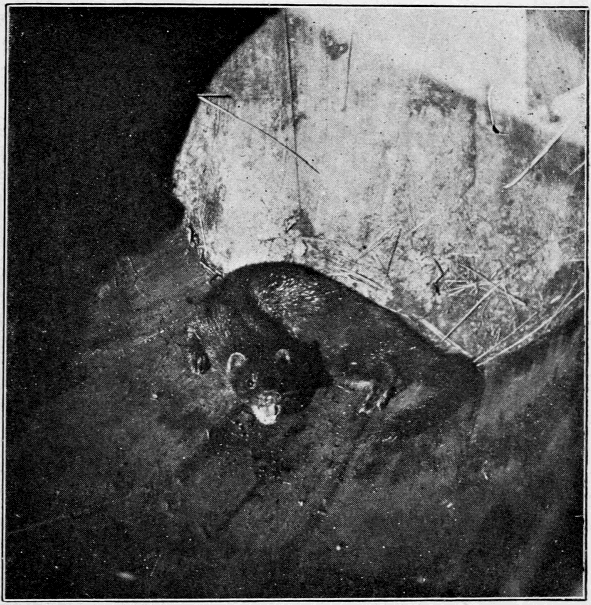
A Louisiana Mink. Notice the Small Eyes, and the Low, Rounded Ears, Scarcely Projecting Beyond the Adjacent Fur.
or the following description of the American mink I am indebted to the Encyclopædia Britannica:
"In size it much resembles the English polecat—the length of the head and body being usually from fifteen to eighteen inches; that of the tail to the end of the hair about nine inches. The female is considerably smaller than the male. The tail is bushy, but tapering at the end. The ears are small, low, rounded, and scarcely project beyond the adjacent fur. The pelage consists of a dense, soft, matted under-fur, mixed with long, stiff, lustrous hairs on all parts of the body and tail. The gloss is greatest on the upper parts; on the tail the bristly hairs predominate. Northern specimens have the finest and most glistening pelage; in those [Pg 8] from the southern regions there is less difference between the under- and over-fur, and the whole pelage is coarser and harsher. In color, different specimens present a considerable range of variation, but the animal is ordinarily of a rich, dark brown, scarcely or not paler below than on the general upper parts; but the back is usually the darkest, and the tail is nearly black. The under jaw, from the chin about as far back as the angle of the mouth, is generally white. In the European mink the upper lip is also white, but, as this occasionally occurs in American specimens, it fails as an absolutely distinguishing character. Besides the white on the chin, there are often other irregular white patches on the under parts of the body. In very rare instances the tail is tipped with white. The fur, like that of most of the animals of the group to which it belongs, is an important article of commerce."
he fur market has always been a good market. It has grown firmer and stronger from year to year, while the prices for furs have been advancing steadily and rapidly with the growing demand for furs in Europe and America, and with the general increasing scarcity of all fur-bearing animals. Mink fur advanced about fifty per cent. during the last two seasons, and there is every reason to believe that the mink fur in Louisiana will advance to about six dollars within the coming three years. The minks caught in Louisiana last season were sold at an average price of three dollars.
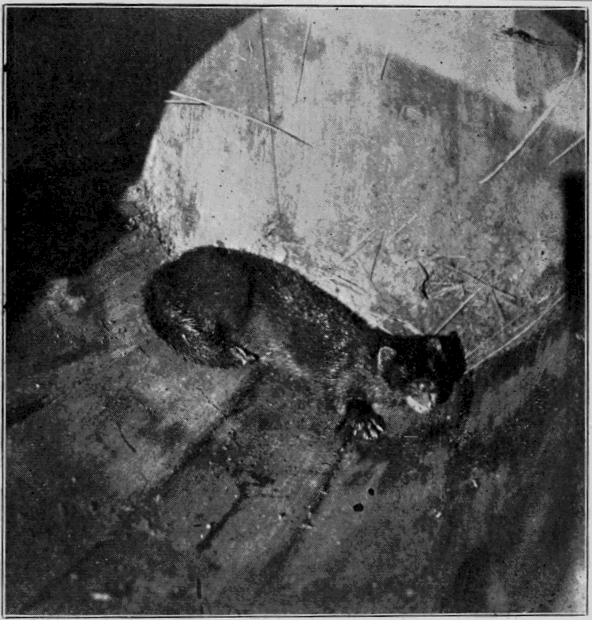
Resting in a Warm Place. Notice the Long Body and Its Shape.
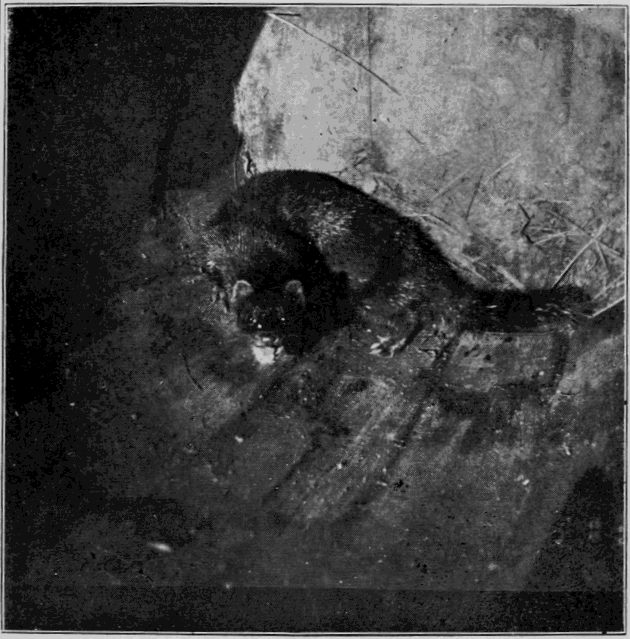
In a Position to Jump. Notice the Long Tail.
ur-bearing animals are becoming scarce where they were once so plentiful, and, like the buffaloes that roamed this country in such great numbers, they will soon, many of them, become extinct if the present rate of trapping continues to obtain in America. Already certain fur animals are almost trapped out and are rare. Even the alligator, which was so plentiful a few years ago in the swamps of Louisiana, is hardly sought after any more for its hide because of its scarcity.
The laws enacted by the various State legislatures for the protection of fur-bearing animals, in fact, offer no protection; for most furs caught out of season have no market value, and for that reason are not caught.
In Louisiana a trapper has to procure a hunting license if he wishes to carry a gun while trapping, which license costs only one dollar and is good for one season only. Such a low license, while it may bring a large revenue to the State, clearly has no element of protection in it. On the contrary, it is a truth that it stimulates both hunting and trapping, as there were more trappers in Louisiana last season than before the law requiring this license came into effect. Every trapper procures a hunting license whether he carries a gun or not, and most [Pg 18] trappers believe the law requires them to have this license to trap.
Whatever is being done for the protection of fur-bearing animals in Louisiana, the fact remains that they are fast disappearing. Old and experienced trappers will tell you that minks were very difficult to trap last season as compared with the seasons of a few years ago, when they could be so easily trapped in dead-falls. Raccoons, too, which were so numerous in the rear of old cornfields during the trapping seasons, have diminished at a surprising rate within the last three years.
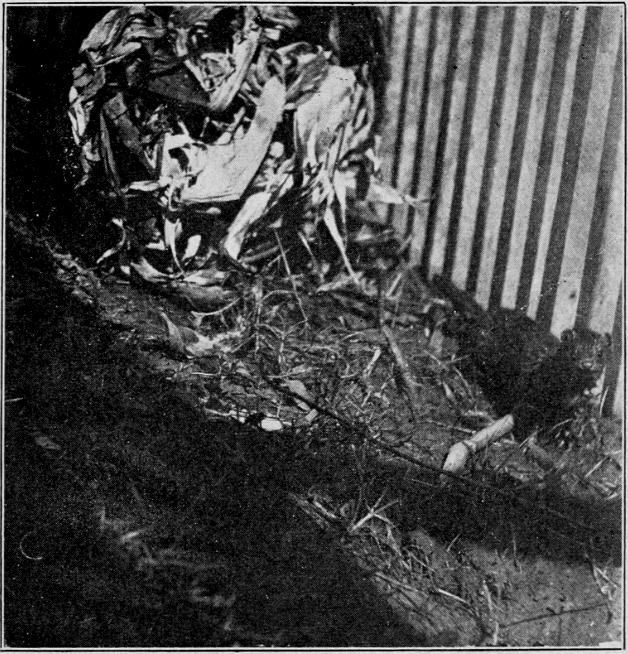
A Female of Two Years.
While laws are being adopted by different States for the regulation of trapping to protect fur-bearing animals, it is time for those who expect to make money with fur in the future to begin raising their own animals. The time is almost here when trapping will be unprofitable. Fur animals will be too scarce to make anything at it. Then people will have to build farms in which to breed minks for their fur, and mink farms will become common. Minks are the most valuable fur-bearing animals in Louisiana, being the most numerous, and they are also the easiest and most profitable to breed for their fur.
Breeding minks in Louisiana for their fur can be made a very profitable industry. There is more to be made at it than raising horses, hogs or cattle. After a farm is once completed and [Pg 22] stocked, all expense is about over if there is a large-enough pond in it to supply the minks with sufficient food. Under the present condition of the fur market, each female will average a profit of forty dollars a year. A farm stocked for the first time during the winter with five hundred female minks should bring its owner the following winter approximately twenty thousand dollars. This is figured at three dollars a fur; but within three years the mink fur in Louisiana should be selling for what the mink fur in the North sold last season. With this increase in the price of fur, a farm stocked with the same number should bring forty thousand dollars.
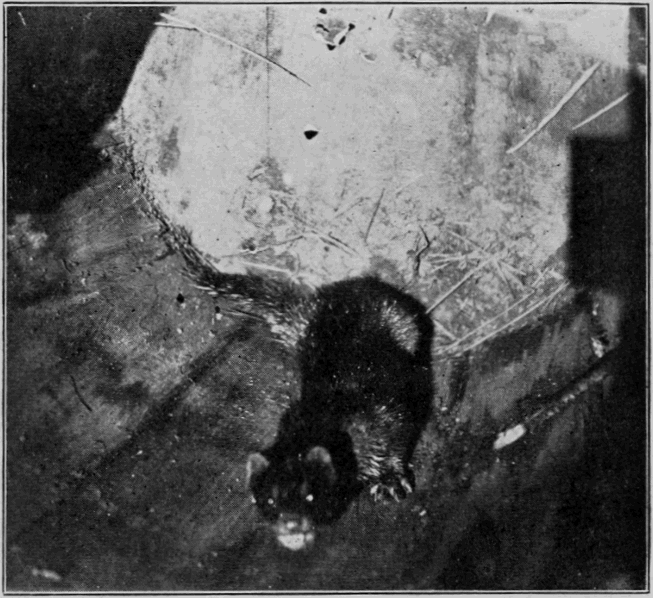
The Fur During the Summer Is Very Poor, and Not So Dark as It Is During the Winter.
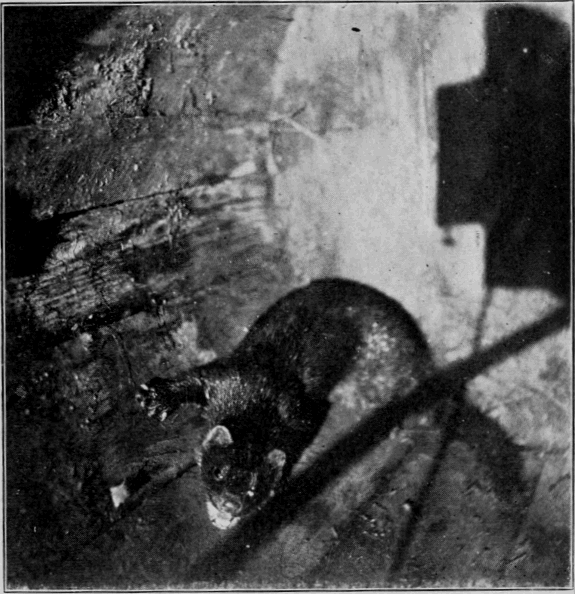
An Excited Mink Trying to Climb.
Minks require little room, and thousands can be raised each year on a farm of ten acres. The larger the farm, however, the better chances they will have to procure food for themselves, as birds will enter a large farm more freely than a small one.
For this reason, in building a mink farm the first and most important requirement is a good location. A small island consisting of low land covered with trees and grasses, with the opposite shore at least three-quarters of a mile distant, would make an excellent farm, provided the surrounding water supplies an abundance of small fishes. Such an island would, of course, preclude the necessity of using material for holding the minks in captivity. If a suitable island cannot be found, a good farm can be made with five or more acres of low swampy land having a natural growth of trees, grasses and underbrush, such as can be found in Southern Louisiana. But the piece of land selected for a farm must inclose a large pond, or several small ponds, containing a good quantity of small fishes, especially crayfish. The trees and grasses will attract birds, which, in addition to fish and rabbits, form a large part of food for the minks.
Feeding minks is pretty costly, and is hardly to be considered by one entering the business of breeding them for their fur.
The walls surrounding a mink farm can be made either with bricks or with sheets of corrugated, galvanized iron. The latter material makes an excellent wall, and costs less than a brick wall. It should be used in sheets measuring twelve feet in length by about twenty-six inches in width. These sheets should be used in an upright position, and at least five feet should be underground and seven feet aboveground. They should be allowed to lap two inches, and the dirt should be firmly packed against them. Two rows of wooden strips nailed on the outside of the wall, one about two feet above the ground, and the other along the top edge of the sheets, will greatly strengthen the wall and also prevent the wind from shaking it.
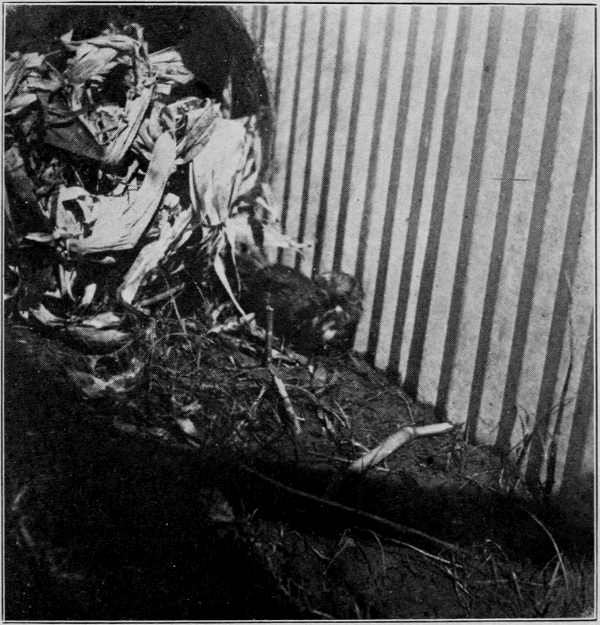
A Young Female Mink Walking Along the Walls of a Small Farm.
The following photograph shows a small pentagonal farm, the walls of which are made with sheets of corrugated, galvanized iron. Each side measures sixteen feet in length, extending four feet underground and four feet aboveground. Wire netting is used to cover the farm, not to prevent the minks from jumping over, although the walls are too low, but to prevent chickens, cats and buzzards from entering and eating the food put in for the minks. A wooden shed also covers a part of the small farm and serves to keep out some of the rain and heat, there being no shrubs or trees therein. There are two [Pg 37] small troughs in the ground for holding water, and in the center of the farm there is a place for the minks to live during the day, which consists of boards laid five inches above the surface of the ground with about fourteen inches of dirt on top. Under these boards it is dark during the day and always damp and cool. There are also several barrels in this farm filled with corn shucks and hay for the minks to enter during cold weather. The minks in this little farm are fed with the spleen of cattle, different meats, crayfish and other small fishes. The cost of this farm, or pen, which has been used for experimental purposes only, amounts to approximately forty-two dollars. It is large enough to raise two hundred minks if they are properly fed and cared for.
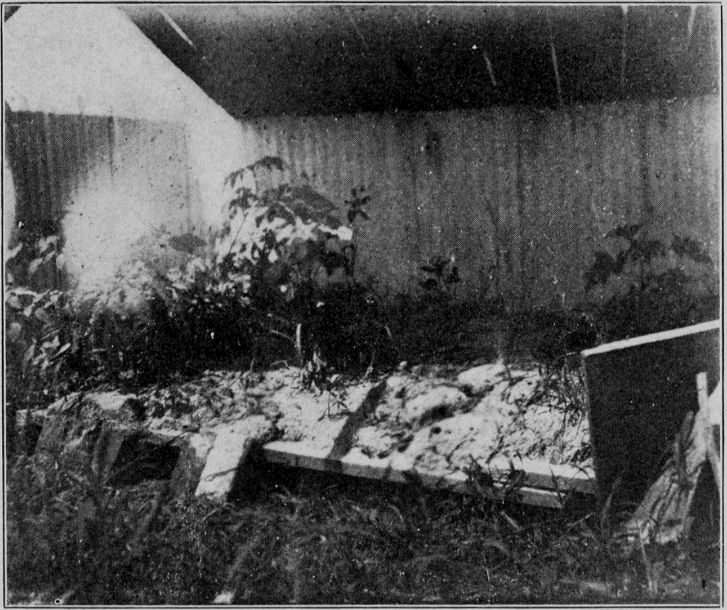
Part of Interior of Small Farm, Showing Boards With Dirt on Top for the Minks to Live Under During the Day.
Sometimes an island can be used for a farm even when it has opposite shores or islands within two hundred feet or less, provided the water surrounding it has an average depth of from four to six feet. In such a case, the walls inclosing the island should be built in the water at a distance of fifty or one hundred feet from its shores. Sheets of metal should be used, as previously described, by placing them upright in the water and nailing them together with strips running along the outside. It is not essential that the lower wall should be in the ground or even touching it; posts can be driven in the ground to strengthen the wall, or to support it entirely.
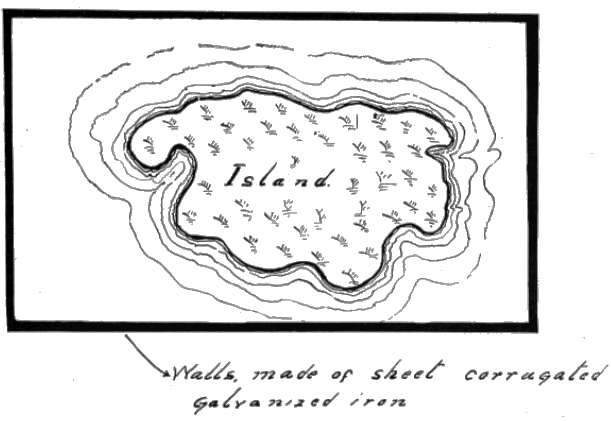
A Mink Farm Made Out of an Island. The Water Surrounding Has a Uniform Depth of Five Feet.
In a small farm where minks are in close captivity and have to be fed, the old ones used for the purpose of stocking it will at first do considerable digging near the walls. They will dig into loose earth to a depth ranging from a few inches to three feet in their attempts to liberate themselves. But they will cease to dig after they have been in captivity for about four months. Those born in a farm will not dig or try to get out. They will climb, however, to a height of fifteen feet on reclining trees or on bushes, and for this reason all trees, bushes and pieces of lumber should be removed from the inside of the walls before any minks are turned loose in a farm. They will ordinarily jump to a height of four feet. They can climb wooden walls as swiftly as a cat, or any wall made of soft material.
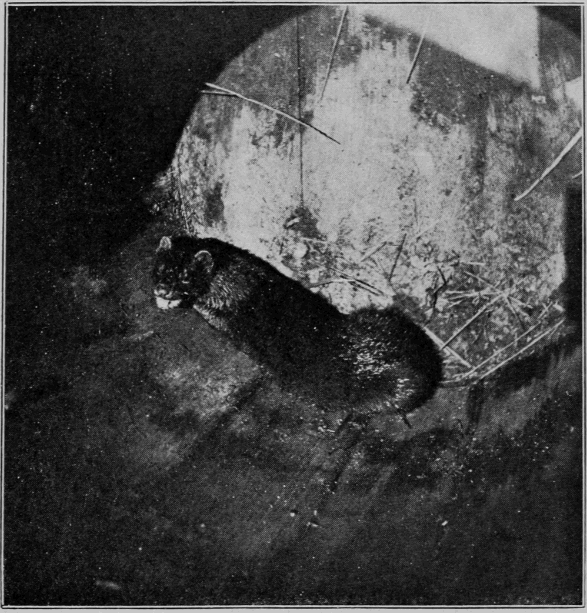
Disturbed in Her Sleep. Notice the Bushy Tail.
The following sketch shows the very best mink farm that can be made. It requires a rectangular piece of land of five or ten acres, running along and separated by a large bayou in the swamps of Louisiana. Covering this land there should be the necessary trees, shrubbery and grasses. The walls are built along the bayou about one hundred feet from the middle, and extend underground to a depth of six feet. The walls at the ends of the farm where they cross the bayou should [Pg 53] be very carefully constructed. At these places where the walls cross the bayou should have a depth of at least twelve feet or more, so that the walls can be made to extend nine feet below the water surface for one-third the width of the stream and still have sufficient openings below the walls to permit the water to flow through freely. For example, if the bayou is fifty feet wide, fifteen feet of the wall crossing it can be elevated so that there will be a large-enough opening below for the water to flow. The remaining portion of the wall (that lying near the shore) should be driven in the ground for about one foot, as minks will not dig under water. A farm of five acres, similar to the one [Pg 54] just described, would cost, completed, approximately eight hundred dollars. The minks in such a farm, owing to the continuous change of water in the bayou, would always have an abundance of food. The banks of the bayou would afford a natural breeding-place, as minks usually burrow in the banks of small streams or along canals and have their young near the water. If the water in the bayou falls, wire netting could be used over the opening at the ends below the walls.
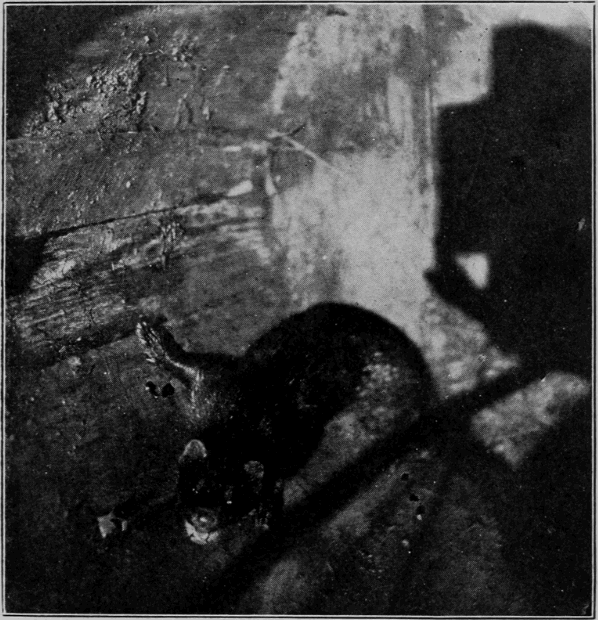
An Angry Mink.
"Minks eat birds, small mammals and eggs. The principal food of minks comes from water, fish, frogs, crayfish."—International Encyclopædia.
The minks I have been experimenting with have persistently refused to eat frogs. I penned one up separately and attempted to feed her on frogs only, and I believe she would have starved rather than eat frogs.
Minks can be raised in any kind of pen or cage, and water is not essential to their happiness. They are easily tamed and like to be petted.


inks in Louisiana have two litters a season, the number of young in each brood varying from four to eight. Sometimes, however, but very rarely, there will be only two in a brood, and almost as infrequently, on the other hand, there will be three litters a season instead of two. Captive animals breed more profusely than the wild, and will occasionally have three litters where they are in close captivity. They begin to breed when they are about one year [Pg 60] old, and in captivity will raise an average of fourteen a year. Normally, they live to be about nine years old, but they will live longer in captivity where they are well treated and given all the water and the different foods required by them.
Like all other industries, the business of breeding minks for their fur necessitates an outlay of capital. A farm cannot be built without money, and the cost of one sufficiently large to breed minks profitably ranges from five hundred to a thousand dollars. Of course, a farm can be made any size and costing any amount of money; but large farms are not necessary, and it is much better to have several small farms of six or ten acres than one very large one.
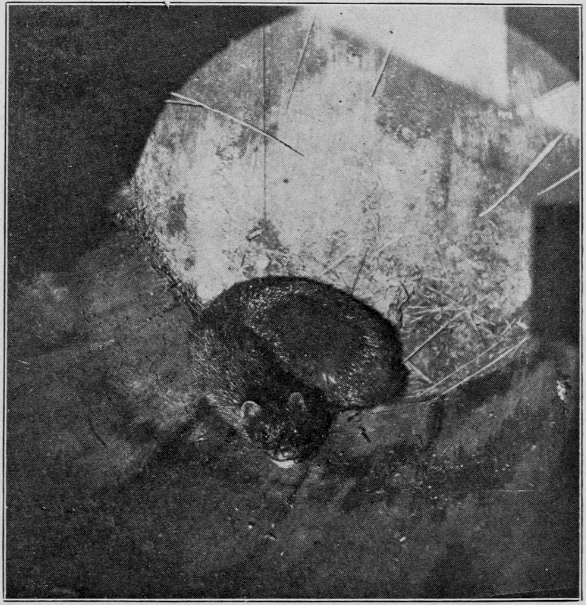
A Female Mink Resting With Eyes Open.
After a farm is completed it has to be stocked, and the task is no easy or inexpensive one. Trappers will have to be employed to trap minks with No. 1 steel traps, as these small traps do not injure them very much unless they are permitted to remain caught too long. Those that have badly-broken bones should not be bought, as suffering will cause them to eat their leg off, in which case they will always die.
The author intends to organize a company styled the "Louisiana Mink Company," the objects and purposes of which shall be to build mink farms and to breed minks in this State for their fur.
No matter what capital is involved, or expense incurred, in entering into the business of breeding minks for their fur, the returns will be so big that this will appear small in comparison. And those who are so fortunate as to start in the industry now will, when minks will have become so rare that trapping will be unprofitable, and the demand so great that the prices for mink fur will soar higher and higher—those persons, I say, of foresight, who had the good fortune to start in the business early, will reap each year the steady advances in the price of mink fur, and be able, in a word, to command the fur market of both Europe and America.
Transcriber's Notes
All obvious typographical corrections were made. All original spelling and gramatic constructs were retained. Some images were moved to rejoin split paragraphs.
End of the Project Gutenberg EBook of Breeding minks in Louisiana for their
fur, by William Andre Elfer
*** END OF THIS PROJECT GUTENBERG EBOOK BREEDING MINKS IN LOUISIANA ***
***** This file should be named 40157-h.htm or 40157-h.zip *****
This and all associated files of various formats will be found in:
http://www.gutenberg.org/4/0/1/5/40157/
Produced by Tom Cosmas and the Online Distributed
Proofreading Team at http://www.pgdp.net (This file was
produced from images generously made available by The
Internet Archive)
Updated editions will replace the previous one--the old editions
will be renamed.
Creating the works from public domain print editions means that no
one owns a United States copyright in these works, so the Foundation
(and you!) can copy and distribute it in the United States without
permission and without paying copyright royalties. Special rules,
set forth in the General Terms of Use part of this license, apply to
copying and distributing Project Gutenberg-tm electronic works to
protect the PROJECT GUTENBERG-tm concept and trademark. Project
Gutenberg is a registered trademark, and may not be used if you
charge for the eBooks, unless you receive specific permission. If you
do not charge anything for copies of this eBook, complying with the
rules is very easy. You may use this eBook for nearly any purpose
such as creation of derivative works, reports, performances and
research. They may be modified and printed and given away--you may do
practically ANYTHING with public domain eBooks. Redistribution is
subject to the trademark license, especially commercial
redistribution.
*** START: FULL LICENSE ***
THE FULL PROJECT GUTENBERG LICENSE
PLEASE READ THIS BEFORE YOU DISTRIBUTE OR USE THIS WORK
To protect the Project Gutenberg-tm mission of promoting the free
distribution of electronic works, by using or distributing this work
(or any other work associated in any way with the phrase "Project
Gutenberg"), you agree to comply with all the terms of the Full Project
Gutenberg-tm License (available with this file or online at
http://gutenberg.org/license).
Section 1. General Terms of Use and Redistributing Project Gutenberg-tm
electronic works
1.A. By reading or using any part of this Project Gutenberg-tm
electronic work, you indicate that you have read, understand, agree to
and accept all the terms of this license and intellectual property
(trademark/copyright) agreement. If you do not agree to abide by all
the terms of this agreement, you must cease using and return or destroy
all copies of Project Gutenberg-tm electronic works in your possession.
If you paid a fee for obtaining a copy of or access to a Project
Gutenberg-tm electronic work and you do not agree to be bound by the
terms of this agreement, you may obtain a refund from the person or
entity to whom you paid the fee as set forth in paragraph 1.E.8.
1.B. "Project Gutenberg" is a registered trademark. It may only be
used on or associated in any way with an electronic work by people who
agree to be bound by the terms of this agreement. There are a few
things that you can do with most Project Gutenberg-tm electronic works
even without complying with the full terms of this agreement. See
paragraph 1.C below. There are a lot of things you can do with Project
Gutenberg-tm electronic works if you follow the terms of this agreement
and help preserve free future access to Project Gutenberg-tm electronic
works. See paragraph 1.E below.
1.C. The Project Gutenberg Literary Archive Foundation ("the Foundation"
or PGLAF), owns a compilation copyright in the collection of Project
Gutenberg-tm electronic works. Nearly all the individual works in the
collection are in the public domain in the United States. If an
individual work is in the public domain in the United States and you are
located in the United States, we do not claim a right to prevent you from
copying, distributing, performing, displaying or creating derivative
works based on the work as long as all references to Project Gutenberg
are removed. Of course, we hope that you will support the Project
Gutenberg-tm mission of promoting free access to electronic works by
freely sharing Project Gutenberg-tm works in compliance with the terms of
this agreement for keeping the Project Gutenberg-tm name associated with
the work. You can easily comply with the terms of this agreement by
keeping this work in the same format with its attached full Project
Gutenberg-tm License when you share it without charge with others.
1.D. The copyright laws of the place where you are located also govern
what you can do with this work. Copyright laws in most countries are in
a constant state of change. If you are outside the United States, check
the laws of your country in addition to the terms of this agreement
before downloading, copying, displaying, performing, distributing or
creating derivative works based on this work or any other Project
Gutenberg-tm work. The Foundation makes no representations concerning
the copyright status of any work in any country outside the United
States.
1.E. Unless you have removed all references to Project Gutenberg:
1.E.1. The following sentence, with active links to, or other immediate
access to, the full Project Gutenberg-tm License must appear prominently
whenever any copy of a Project Gutenberg-tm work (any work on which the
phrase "Project Gutenberg" appears, or with which the phrase "Project
Gutenberg" is associated) is accessed, displayed, performed, viewed,
copied or distributed:
This eBook is for the use of anyone anywhere at no cost and with
almost no restrictions whatsoever. You may copy it, give it away or
re-use it under the terms of the Project Gutenberg License included
with this eBook or online at www.gutenberg.org/license
1.E.2. If an individual Project Gutenberg-tm electronic work is derived
from the public domain (does not contain a notice indicating that it is
posted with permission of the copyright holder), the work can be copied
and distributed to anyone in the United States without paying any fees
or charges. If you are redistributing or providing access to a work
with the phrase "Project Gutenberg" associated with or appearing on the
work, you must comply either with the requirements of paragraphs 1.E.1
through 1.E.7 or obtain permission for the use of the work and the
Project Gutenberg-tm trademark as set forth in paragraphs 1.E.8 or
1.E.9.
1.E.3. If an individual Project Gutenberg-tm electronic work is posted
with the permission of the copyright holder, your use and distribution
must comply with both paragraphs 1.E.1 through 1.E.7 and any additional
terms imposed by the copyright holder. Additional terms will be linked
to the Project Gutenberg-tm License for all works posted with the
permission of the copyright holder found at the beginning of this work.
1.E.4. Do not unlink or detach or remove the full Project Gutenberg-tm
License terms from this work, or any files containing a part of this
work or any other work associated with Project Gutenberg-tm.
1.E.5. Do not copy, display, perform, distribute or redistribute this
electronic work, or any part of this electronic work, without
prominently displaying the sentence set forth in paragraph 1.E.1 with
active links or immediate access to the full terms of the Project
Gutenberg-tm License.
1.E.6. You may convert to and distribute this work in any binary,
compressed, marked up, nonproprietary or proprietary form, including any
word processing or hypertext form. However, if you provide access to or
distribute copies of a Project Gutenberg-tm work in a format other than
"Plain Vanilla ASCII" or other format used in the official version
posted on the official Project Gutenberg-tm web site (www.gutenberg.org),
you must, at no additional cost, fee or expense to the user, provide a
copy, a means of exporting a copy, or a means of obtaining a copy upon
request, of the work in its original "Plain Vanilla ASCII" or other
form. Any alternate format must include the full Project Gutenberg-tm
License as specified in paragraph 1.E.1.
1.E.7. Do not charge a fee for access to, viewing, displaying,
performing, copying or distributing any Project Gutenberg-tm works
unless you comply with paragraph 1.E.8 or 1.E.9.
1.E.8. You may charge a reasonable fee for copies of or providing
access to or distributing Project Gutenberg-tm electronic works provided
that
- You pay a royalty fee of 20% of the gross profits you derive from
the use of Project Gutenberg-tm works calculated using the method
you already use to calculate your applicable taxes. The fee is
owed to the owner of the Project Gutenberg-tm trademark, but he
has agreed to donate royalties under this paragraph to the
Project Gutenberg Literary Archive Foundation. Royalty payments
must be paid within 60 days following each date on which you
prepare (or are legally required to prepare) your periodic tax
returns. Royalty payments should be clearly marked as such and
sent to the Project Gutenberg Literary Archive Foundation at the
address specified in Section 4, "Information about donations to
the Project Gutenberg Literary Archive Foundation."
- You provide a full refund of any money paid by a user who notifies
you in writing (or by e-mail) within 30 days of receipt that s/he
does not agree to the terms of the full Project Gutenberg-tm
License. You must require such a user to return or
destroy all copies of the works possessed in a physical medium
and discontinue all use of and all access to other copies of
Project Gutenberg-tm works.
- You provide, in accordance with paragraph 1.F.3, a full refund of any
money paid for a work or a replacement copy, if a defect in the
electronic work is discovered and reported to you within 90 days
of receipt of the work.
- You comply with all other terms of this agreement for free
distribution of Project Gutenberg-tm works.
1.E.9. If you wish to charge a fee or distribute a Project Gutenberg-tm
electronic work or group of works on different terms than are set
forth in this agreement, you must obtain permission in writing from
both the Project Gutenberg Literary Archive Foundation and Michael
Hart, the owner of the Project Gutenberg-tm trademark. Contact the
Foundation as set forth in Section 3 below.
1.F.
1.F.1. Project Gutenberg volunteers and employees expend considerable
effort to identify, do copyright research on, transcribe and proofread
public domain works in creating the Project Gutenberg-tm
collection. Despite these efforts, Project Gutenberg-tm electronic
works, and the medium on which they may be stored, may contain
"Defects," such as, but not limited to, incomplete, inaccurate or
corrupt data, transcription errors, a copyright or other intellectual
property infringement, a defective or damaged disk or other medium, a
computer virus, or computer codes that damage or cannot be read by
your equipment.
1.F.2. LIMITED WARRANTY, DISCLAIMER OF DAMAGES - Except for the "Right
of Replacement or Refund" described in paragraph 1.F.3, the Project
Gutenberg Literary Archive Foundation, the owner of the Project
Gutenberg-tm trademark, and any other party distributing a Project
Gutenberg-tm electronic work under this agreement, disclaim all
liability to you for damages, costs and expenses, including legal
fees. YOU AGREE THAT YOU HAVE NO REMEDIES FOR NEGLIGENCE, STRICT
LIABILITY, BREACH OF WARRANTY OR BREACH OF CONTRACT EXCEPT THOSE
PROVIDED IN PARAGRAPH 1.F.3. YOU AGREE THAT THE FOUNDATION, THE
TRADEMARK OWNER, AND ANY DISTRIBUTOR UNDER THIS AGREEMENT WILL NOT BE
LIABLE TO YOU FOR ACTUAL, DIRECT, INDIRECT, CONSEQUENTIAL, PUNITIVE OR
INCIDENTAL DAMAGES EVEN IF YOU GIVE NOTICE OF THE POSSIBILITY OF SUCH
DAMAGE.
1.F.3. LIMITED RIGHT OF REPLACEMENT OR REFUND - If you discover a
defect in this electronic work within 90 days of receiving it, you can
receive a refund of the money (if any) you paid for it by sending a
written explanation to the person you received the work from. If you
received the work on a physical medium, you must return the medium with
your written explanation. The person or entity that provided you with
the defective work may elect to provide a replacement copy in lieu of a
refund. If you received the work electronically, the person or entity
providing it to you may choose to give you a second opportunity to
receive the work electronically in lieu of a refund. If the second copy
is also defective, you may demand a refund in writing without further
opportunities to fix the problem.
1.F.4. Except for the limited right of replacement or refund set forth
in paragraph 1.F.3, this work is provided to you 'AS-IS' WITH NO OTHER
WARRANTIES OF ANY KIND, EXPRESS OR IMPLIED, INCLUDING BUT NOT LIMITED TO
WARRANTIES OF MERCHANTABILITY OR FITNESS FOR ANY PURPOSE.
1.F.5. Some states do not allow disclaimers of certain implied
warranties or the exclusion or limitation of certain types of damages.
If any disclaimer or limitation set forth in this agreement violates the
law of the state applicable to this agreement, the agreement shall be
interpreted to make the maximum disclaimer or limitation permitted by
the applicable state law. The invalidity or unenforceability of any
provision of this agreement shall not void the remaining provisions.
1.F.6. INDEMNITY - You agree to indemnify and hold the Foundation, the
trademark owner, any agent or employee of the Foundation, anyone
providing copies of Project Gutenberg-tm electronic works in accordance
with this agreement, and any volunteers associated with the production,
promotion and distribution of Project Gutenberg-tm electronic works,
harmless from all liability, costs and expenses, including legal fees,
that arise directly or indirectly from any of the following which you do
or cause to occur: (a) distribution of this or any Project Gutenberg-tm
work, (b) alteration, modification, or additions or deletions to any
Project Gutenberg-tm work, and (c) any Defect you cause.
Section 2. Information about the Mission of Project Gutenberg-tm
Project Gutenberg-tm is synonymous with the free distribution of
electronic works in formats readable by the widest variety of computers
including obsolete, old, middle-aged and new computers. It exists
because of the efforts of hundreds of volunteers and donations from
people in all walks of life.
Volunteers and financial support to provide volunteers with the
assistance they need, are critical to reaching Project Gutenberg-tm's
goals and ensuring that the Project Gutenberg-tm collection will
remain freely available for generations to come. In 2001, the Project
Gutenberg Literary Archive Foundation was created to provide a secure
and permanent future for Project Gutenberg-tm and future generations.
To learn more about the Project Gutenberg Literary Archive Foundation
and how your efforts and donations can help, see Sections 3 and 4
and the Foundation web page at http://www.pglaf.org.
Section 3. Information about the Project Gutenberg Literary Archive
Foundation
The Project Gutenberg Literary Archive Foundation is a non profit
501(c)(3) educational corporation organized under the laws of the
state of Mississippi and granted tax exempt status by the Internal
Revenue Service. The Foundation's EIN or federal tax identification
number is 64-6221541. Its 501(c)(3) letter is posted at
http://pglaf.org/fundraising. Contributions to the Project Gutenberg
Literary Archive Foundation are tax deductible to the full extent
permitted by U.S. federal laws and your state's laws.
The Foundation's principal office is located at 4557 Melan Dr. S.
Fairbanks, AK, 99712., but its volunteers and employees are scattered
throughout numerous locations. Its business office is located at
809 North 1500 West, Salt Lake City, UT 84116, (801) 596-1887, email
[email protected]. Email contact links and up to date contact
information can be found at the Foundation's web site and official
page at http://pglaf.org
For additional contact information:
Dr. Gregory B. Newby
Chief Executive and Director
[email protected]
Section 4. Information about Donations to the Project Gutenberg
Literary Archive Foundation
Project Gutenberg-tm depends upon and cannot survive without wide
spread public support and donations to carry out its mission of
increasing the number of public domain and licensed works that can be
freely distributed in machine readable form accessible by the widest
array of equipment including outdated equipment. Many small donations
($1 to $5,000) are particularly important to maintaining tax exempt
status with the IRS.
The Foundation is committed to complying with the laws regulating
charities and charitable donations in all 50 states of the United
States. Compliance requirements are not uniform and it takes a
considerable effort, much paperwork and many fees to meet and keep up
with these requirements. We do not solicit donations in locations
where we have not received written confirmation of compliance. To
SEND DONATIONS or determine the status of compliance for any
particular state visit http://pglaf.org
While we cannot and do not solicit contributions from states where we
have not met the solicitation requirements, we know of no prohibition
against accepting unsolicited donations from donors in such states who
approach us with offers to donate.
International donations are gratefully accepted, but we cannot make
any statements concerning tax treatment of donations received from
outside the United States. U.S. laws alone swamp our small staff.
Please check the Project Gutenberg Web pages for current donation
methods and addresses. Donations are accepted in a number of other
ways including checks, online payments and credit card donations.
To donate, please visit: http://pglaf.org/donate
Section 5. General Information About Project Gutenberg-tm electronic
works.
Professor Michael S. Hart is the originator of the Project Gutenberg-tm
concept of a library of electronic works that could be freely shared
with anyone. For thirty years, he produced and distributed Project
Gutenberg-tm eBooks with only a loose network of volunteer support.
Project Gutenberg-tm eBooks are often created from several printed
editions, all of which are confirmed as Public Domain in the U.S.
unless a copyright notice is included. Thus, we do not necessarily
keep eBooks in compliance with any particular paper edition.
Most people start at our Web site which has the main PG search facility:
http://www.gutenberg.org
This Web site includes information about Project Gutenberg-tm,
including how to make donations to the Project Gutenberg Literary
Archive Foundation, how to help produce our new eBooks, and how to
subscribe to our email newsletter to hear about new eBooks.